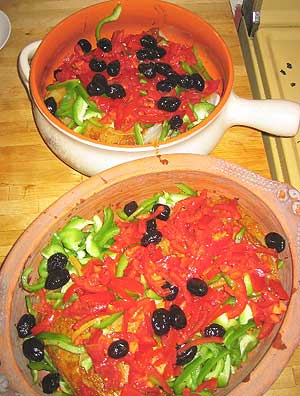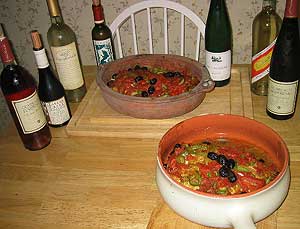
|
|
|
by Carolyn Tillie |
|
|
|
1. Early in the day, or the day before, make the charmoula: In a
blender, combine the garlic, spices, herbs, and pepper flakes. Add the
lemon juice and olive oil and blend until smooth. Scrape the mixture
into a small saucepan and heat it slowly, stirring, until hot and
aromatic, about 30 seconds; do not boil. Let it cool, then divide the
spice mixture, or charmoula, in half. 2. Rinse the fish and pat it dry with paper towels. Rub one portion of the spice mixture into the fish and let it stand at least 1 hour, or overnight. Add 1/2 cup of the hot water to the remaining spice mixture, cover, and refrigerate separately (The recipe can be prepared to this point a day ahead.) 3. About 1 1/2 hours before serving, preheat the oven to 300(F. Spread 2 tablespoons of reserved charmoula over the bottom of a shallow 2 1/2-quart baking-serving dish (about 10 inches in diameter). Scatter the carrots on the bottom of the dish. Sprinkle with a little charmoula. Add half the tomatoes, bell peppers, and chili pepper; sprinkle with a little charmoula. Lay the fish over the vegetables and cover with the preserved lemon peel and the remaining tomatoes and peppers in a decorative pattern. Spread the remaining charmoula over all and scatter olives around. Cover the dish tightly with foil and bake for 45 minutes. 4. Pour off the liquid from the fish into a small non-corrodible saucepan. Bring it to a boil over moderately high heat and boil until it is reduced to 1/2 cup of thick liquid. Pour it back over the fish. (The dish can be prepared up to 1 hour ahead to this point). 5. Raise the oven temperature to 500(F. Uncover the baking dish, baste with the pan juices, and bake in the top third of the oven for 10 minutes, or until a nice crust has formed over the vegetables. Sprinkle with parsley and garnish with sprigs of coriander. Serve warm. |
|
|
|
|
| A word on the clay pots. The oval, darker pot is known as a Tagra and is unglazed. Now that it has been cooked with fish, it will be relegated to the "only ever use with fish" pile. The round, handled clay pot is better known for making cassoulet and has a glazed interior. The flavors of the fish become imbued into the clay of the Tagra and should I ever use it to, say, roast a chicken, than that chicken might taste a tad fishy. Also, as expected, the unglazed clay pot was ultimately the preferred cooking method for this dish. The flavors of the fish were more rustic and the spice flavors permeated the roasted vegetables with more depth. The vegetables in the glazed pot seemed to lack an intensity of flavors. Truly astonishing... | |
|
|
|
|
2003
Civello Pinot Gris - Produced by Row Eleven from Oregon
grapes, the wine is reminiscent of a rich Sauvignon Blanc with a hint of
clean grass in the nose. The mouthfeel is initially crisp and light, but
broadens to display hints of gooseberry.
2004
Gundlach-Bundschu Gewurztraminer - White flowers and
grapefruit play on the nose. Slightly effervescent mouth entry shows
balanced spice and crisp flavors of white peach, pear, and rich citrus. |
|
|
|
|
|
These are the basics of the wine notes, but the purpose of all this was
a determination of wine pairings. The charmoula was not overly
spicy, but when cooked with the preserved lemon, created dark and rustic
flavor sensations with an occasional spike of aged citrus that made a
wine pairing difficult.
In this respect, the Sauvignon Blanc and Riesling
were the least successful. The Sauvignon Blanc, which was surprisingly
elegant and rich, became strident and harsh. The Riesling, which I adore
for its whisper of sweetness, became medicinal. The rosé, which was not a sickly sweet version and usually shows depth and balance, became a candy shop of nasty, oddly artificial flavors. The cherry and raspberry flavors in the wine seemed enhanced to a degree that would be found in dime-store candy. The Gewurztraminer, not too surprisingly, became sweeter next to the spices. This is often why Alsatian-style Gewurtztraminers are recommended for spicy Asian food; the hint of sweetness counter-balances the bite of a pepper. In this case, I might almost suggest that the charmoula was not spicy enough and the occasional bite with preserved lemon conflicted with the wine. However, the depth of rustic earthiness provided by the olives were a perfect pairing to the wine. Similarly, the Pinot Gris was rich before the food pairing, but thinned out and became almost beer-like when paired with the cumin and paprika. This leads us with Roussannes. Hands-down an amazing pairing. The viscosity of the two wines helped coat the tongue and showed balanced acidity. The spices seemed enhanced and while they were not hotter or more mouth-burning, they showed more rustic depth and integration with the fish. The occasional bite of preserved lemon complemented the citrus qualities in the wine and the olives provided a punctuation of provincial perfection ultimately showing that such a complex dish - and I hope to prove that others - are well-suited to wine, once one figures out the best route to take is through experimentation and choice. |
|
|
|
|
|
Previously from Carolyn Tillie: CAROLYN TILLIE'S HOME PAGE AND MAIN INDEX
|
|



